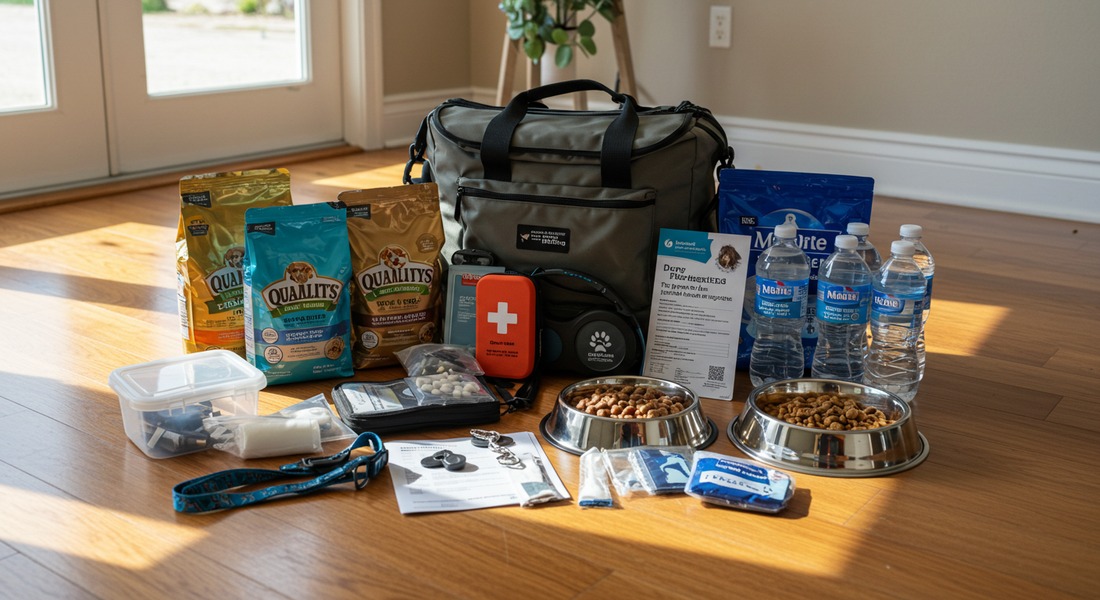
Don't Forget Fido: The Complete Guide to Pet Disaster Preparedness
Share

When we create our family emergency plans, we think about food, water, and first aid for the humans in our household. But for millions of us, our family isn't complete without our furry, scaled, or feathered members. In a crisis, your pet is completely dependent on you for their safety.
That's why your disaster preparedness for pets needs to be just as detailed and practiced as your plan for the rest of your family. An emergency is a stressful and confusing time for an animal, and a thorough plan is the best way to keep them safe and reduce their anxiety.
Building the Ultimate Pet Go-Bag
Just like you have a "bug out bag," your pet needs one too. This pet emergency kit should be packed in an easy-to-grab bag or container and kept with the rest of your emergency supplies.
-
Food, Water, and Bowls: Pack at least a three-day supply of your pet's regular food in a waterproof container. Include a can of wet food, even if you normally feed dry, as it's an excellent source of hydration. Have at least a three-day supply of water specifically for your pet. Collapsible food and water bowls are a fantastic space-saver.
-
Medications and Pet First-Aid Kit: Pack a two-week supply of any necessary medications. Your pet's first-aid kit should include items like non-stick bandages, antiseptic wipes, and a pet-specific first-aid manual.
-
Leash, Harness, Carrier, and Muzzle: In a stressful situation, even the calmest pet can bolt. You must have a secure way to restrain them. This includes a sturdy leash and harness (harnesses are harder to slip out of than collars), and a properly sized carrier for smaller animals. Even if your dog is not aggressive, it's wise to pack a muzzle, as some emergency shelters may require them.
Evacuation and Shelter-in-Place Strategy
Your animal evacuation plan must be established long before you ever need it. Never assume you will be able to return home for your pets if you have to leave in a hurry.
-
Research Pet-Friendly Locations: Not all emergency shelters accept pets (with the exception of service animals). Do your research now. Compile a list of pet-friendly hotels, motels, and boarding facilities along your evacuation routes. Also, talk to friends and family outside your immediate area to see if they could house you and your pets in an emergency.
-
Keep Pets Calm: An evacuation is terrifying for animals. Keep them in their carrier or on a leash and harness at all times when outside your home. Bring a favorite toy, blanket, or bed that smells like home to provide a sense of comfort and familiarity.
Identification and Important Documents
Proper identification can be the difference between being reunited with a lost pet and a heartbreaking separation.
-
Microchips and ID Tags: A microchip is the most reliable form of permanent identification. Make sure the chip is registered and your contact information is always up to date. Your pet should also wear a collar with an ID tag that includes their name, your phone number, and any urgent medical needs.
-
Store Important Documents: Keep a copy of your pet's vaccination and medical records, your veterinarian's contact information, and a recent, clear photo of you with your pet in a waterproof bag inside their go-bag. This is crucial for proving ownership and getting them into a shelter or boarding facility.
Conclusion: A Prepared Pet is a Safe Pet
Integrating your pets into your family safety drills is a vital part of preparedness. Get them used to their carriers and practice loading them into the car quickly and calmly. The responsibility of being a pet owner extends to their safety in a crisis. Building a comprehensive dog bug out bag and having a clear plan doesn't just protect them; it provides you with the peace of mind that comes from knowing you've done everything you can to keep your entire family safe, Fido included.
